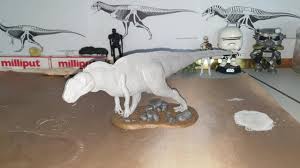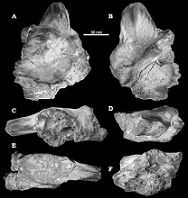
Sauroniops is a genus of theropod Dinosaur that lived during the Late Cretaceous period, approximately 95 million years ago. This remarkable dinosaur is known for its striking appearance, which includes a massive skull adorned with formidable horns above its eyes. In this 500-word exploration, we will delve into the classification, physical characteristics, habitat, behavior, and the significance of Sauroniops in the world of paleontology.
Sauroniops is classified as a theropod, a group of bipedal, carnivorous dinosaurs that includes famous relatives like Tyrannosaurus rex and Velociraptor. The name Sauroniops is derived from Sauron the iconic antagonist from J.R.R. Tolkien's The Lord of the Rings, due to the dinosaur's eye-catching eye socket shape.
| Name: | Sauroniops dinosaurs |
| Size: | Around 20 feet (6 meters) in length. |
| Main Facts: | Sauroniops, a Late Cretaceous theropod, is distinguished by its distinctive eye horns and remains a subject of intrigue in paleontology. |
The first and only known fossils of Sauroniops were discovered in southeastern Morocco. The primary specimen consists of a partial skull, including the distinctive eye horns and portions of the lower jaw. This limited fossil record has made Sauroniops a relatively enigmatic dinosaur.

Sauroniops possessed several noteworthy physical characteristics :
The most prominent feature of Sauroniops is its pair of horns above its eyes. These bony projections give it a unique and menacing appearance, which is uncommon among theropods. The function of these horns is still a subject of speculation.
While the exact size of Sauroniops is uncertain due to the limited fossil evidence, it is believed to have been a medium-sized theropod dinosaur, possibly reaching lengths of around 20 feet (6 meters).
Like other theropods, Sauroniops walked on two legs, and its limbs were adapted for predatory behavior.
Sauroniops was a carnivore, equipped with sharp teeth designed for tearing into prey. Its diet likely consisted of other smaller dinosaurs and potentially other animals in its ecosystem.
Sauroniops lived during the Late Cretaceous, a time when dinosaurs were abundant and diverse. The fossils of Sauroniops were discovered in what is now the Sahara Desert, indicating that it inhabited this region during the Late Cretaceous.The function of the distinctive eye horns on Sauroniops remains a subject of scientific speculation. Some theories suggest that these horns may have served for display or as weapons in intraspecific combat, similar to the head ornaments seen in modern-day animals like deer.
Sauroniops was a carnivorous predator, and its adaptations for hunting would have included keen senses, agility, and sharp teeth. It likely pursued and captured prey in its ecosystem, contributing to the complex predator-prey interactions of the Late Cretaceous.
Sauroniops holds significance in the field of paleontology for several reasons :
Its striking appearance, characterized by the eye horns, sets Sauroniops apart from many other theropod dinosaurs, making it a subject of fascination and curiosity.
Fossils of Sauroniops provide valuable insights into the Late Cretaceous ecosystems of North Africa and the diversity of theropods that inhabited this region.
The ongoing research into the function and purpose of the eye horns of Sauroniops highlights the complexity of dinosaur behavior, communication, and adaptation.
Sauroniops is a Late Cretaceous theropod known for its striking appearance, featuring prominent horns above its eyes. Although its exact size is uncertain, it was likely a medium-sized predator. Its bipedal stance, sharp teeth, and carnivorous diet suggest a predatory lifestyle, preying on other dinosaurs and creatures in its ecosystem.
Fossils of Sauroniops have been found in southeastern Morocco, shedding light on its presence in North Africa during the Late Cretaceous. The distinctive eye horns, whose function remains speculative, set Sauroniops apart, making it a subject of intrigue and curiosity in the world of paleontology.
Sauroniops stands out with its prominent eye horns, a feature not commonly seen in other dinosaurs. While some ceratopsids also had horns, the location and purpose of Sauroniops' horns remain unclear.
Sauroniops, as a theropod, shared its carnivorous diet with other predators like Tyrannosaurus rex and Velociraptor. However, its eye-catching horns distinguish it from these more well-known theropods.
Sauroniops lived during the Late Cretaceous, coexisting with a diverse array of dinosaurs. Comparisons with contemporaneous species in North Africa reveal the region's unique paleoecology.
One of the most significant differences is the scarcity of Sauroniops fossils compared to other dinosaurs. This limited record makes it challenging to reconstruct its biology, behavior, and place in the ecosystem.
The eye horns of Sauroniops are unlike the frills of ceratopsids, and their function remains a mystery. Contrasting with the clear defensive role of ceratopsid frills, Sauroniops' horns raise questions about their use in display, communication, or combat.
Sauroniops was found in Morocco, providing insights into the dinosaurs of North Africa. Comparisons with other theropods in different regions highlight regional variations in Late Cretaceous ecosystems.